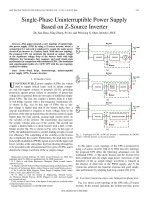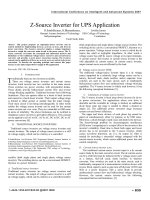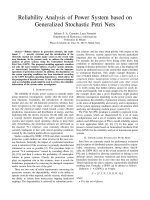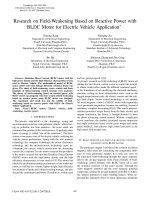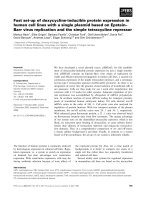Single phase uninterruptible power supply based on z source inverter
Bạn đang xem bản rút gọn của tài liệu. Xem và tải ngay bản đầy đủ của tài liệu tại đây (635.85 KB, 8 trang )
IEEE TRANSACTIONS ON INDUSTRIAL ELECTRONICS, VOL. 55, NO. 8, AUGUST 2008 2997
Single-Phase Uninterruptible Power Supply
Based on Z-Source Inverter
Zhi Jian Zhou, Xing Zhang, Po Xu, and Weixiang X. Shen, Member, IEEE
Abstract—This paper presents a new topology of uninterrupt-
ible power supply (UPS) by using a Z-source inverter, where a
symmetrical LC network is employed to couple the main power
circuit of an inverter to a battery bank. With this new topology,
the proposed UPS can maintain the desired ac output voltage
at the significant voltage drop of the battery bank with high
efficiency, low harmonics, fast response, and good steady-state
performance in comparison with traditional UPSs. The simulation
and experimental results of a 3-kW UPS with the new topology
confirm its validity.
Index Terms—Dual loops, shoot-through, uninterruptible
power supply (UPS), Z-source inverter.
I. I
NTRODUCTION
U
NINTERRUPTIBLE power supplies (UPSs) are widely
used to supply critical loads, such as airline comput-
ers and life-support systems in hospitals [1]–[5], providing
protection against power failure or anomalies of power-line
voltage [6]. In general, there are two types of traditional single-
phase UPSs. The first one couples a battery bank to a half-
or full-bridge inverter with a low-frequency transformer [7],
as shown in Fig. 1(a). In this type of UPSs, the ac out-
put voltage is higher than that of the battery bank; thus, a
step-up transformer is required to boost voltage. Due to the
presence of the step-up transformer, the inverter current is much
higher than the load current, causing high current stress on
the switches of the inverter. The transformer also increases
the weight, volume, and cost of the system. The second one
couples a battery bank to a dc/dc booster with a half- or full-
bridge inverter [8], [9], as shown in Fig. 1(b). In this type of
UPSs, the additional booster is needed, leading to high cost and
low efficiency. The controlling of the switches in the booster
also complicates the system. Furthermore, the dead time in the
pulsewidth-modulation (PWM) signals to prevent the upper and
lower switches at the same phase leg from shooting through has
to be provided in the aforementioned two types of UPSs, and it
distorts the voltage waveform of the ac output voltage.
Manuscript received February 28, 2007; revised February 18, 2008. First
published April 25, 2008; last published July 30, 2008 (projected).
Z. J. Zhou is with Delta Electronics, Shanghai, China (e-mail: bonwe_
).
X. Zhang is with the School of Electrical Engineering and Automation, Hefei
University of Technology, Hefei, Anhui, China (e-mail: ).
P. Xu is with the Hefei Sungrow Power Supply Company, Hefei, Anhui,
China (e-mail: ).
W. X. Shen is with the School of Engineering, Monash Univer-
sity Malaysia, Bandar Sunway 46150, Malaysia (e-mail: shen.wei.xiang@
eng.monash.edu.my).
Color versions of one or more of the figures in this paper are available online
at .
Digital Object Identifier 10.1109/TIE.2008.924202
Fig. 1. Topologies of UPS. (a) DC/AC inverter + transformer. (b) DC/DC
booster + DC/AC inverter. (c) Z-source inverter.
In this paper, a new topology of the UPS is proposed by
using a Z-source inverter [10]–[13]. With this new topology,
the proposed UPS offers the following advantages over the
traditional UPSs: 1) The dc/dc booster and the inverter have
been combined into one single-stage power conversion; 2) the
distortion of the ac output-voltage waveform is reduced in
the absence of dead time in the PWM signals; and 3) the
system has achieved fast transient response and good steady-
state performance by adopting dual-loop control [14]–[19].
II. S
YSTEM
C
ONFIGURATION AND
O
PERATING
P
RINCIPLE
Fig. 1(c) shows a new topology of the UPS with a Z-source
inverter. In the normal operation, the rectifier provides power
0278-0046/$25.00 © 2008 IEEE
2998 IEEE TRANSACTIONS ON INDUSTRIAL ELECTRONICS, VOL. 55, NO. 8, AUGUST 2008
Fig. 2. Z-source inverter for the proposed UPS.
TABLE I
S
WITCHING
S
TATES AND
V
ECTOR
R
EPRESENTATIONS
OF THE
Z-S
OURCE
I
NVERTER
to the inverter. In the case of power outage, the battery bank
supplies the inverter, as shown in Fig. 2. It consists of a
dc source (E, C
3
, and D), a Z-source symmetrical network
(L
1
=L
2
and C
1
=C
2
), an H-bridge inverter (S
1
–S
4
), and a
filter (L
s
and C
s
).
Table I shows a total of nine switching states and their
vector representations, where the switching function S
x
(x =
1, 2, 3, or 4) is defined as 1 when switch S
x
turns on and as
0 when switch S
x
turns off. Thus, when two active vectors
({1 0}, {0 1}) are taken, the battery bank voltage is applied to
the load through two inductances (L
1
and L
2
); when two null
vectors ({0 0}, {1 1}) are taken, the load terminal is shorted by
either the upper or lower two switches; when the shoot-through
zero vectors are taken, the load is shorted by the upper and
lower switches at the same phase leg. These zero vectors are
allowed in the Z-source inverter, whereas they are forbidden in
the voltage source inverter. Because of this unique feature of the
Z-source inverter, the proposed UPS can generate the desired ac
output voltage u
o
, regardless of the battery bank voltage u
B
,by
using the shoot-through zero vectors.
As shown in Fig. 2, the voltage equations of the Z-source
inverter [10], [20] can be written as
u
C1
= u
C2
= u
C
u
L1
= u
L2
= u
L
. (1)
When the Z-source inverter is working in nonshoot-through
states during time interval T
1
, the diode D is on, and the
H-bridge inverter can be considered as a current source i
in
.
Consequently, the equivalent circuit of the Z-source inverter at
nonshoot-through states is shown in Fig. 3(a), and its voltage
equations are
u
B
= u
d
= u
C
+ u
L
(2)
u
in
= u
C
− u
L
. (3)
Substituting (2) into (3) yields
u
in
=2u
C
− u
B
. (4)
When the Z-source inverter is working in shoot-through states
during time interval T
0
, where T
0
= T
s
− T
1
, and T
s
is the
switching period, the diode D is off, and the H-bridge inverter
can be considered as a short circuit. As a result, the equivalent
circuit of the Z-source inverter at shoot-through states is shown
in Fig. 3(b), and its voltage equations are
u
C
= u
L
u
in
=0. (5)
It is recognized that the average voltage of inductor L
1
(or L
2
)
over one switching period in steady-state operation is zero
(u
B
− u
C
)T
1
+ u
C
T
0
=0 (6)
ZHOU et al.: SINGLE-PHASE UNINTERRUPTIBLE POWER SUPPLY BASED ON Z-SOURCE INVERTER 2999
Fig. 3. Equivalent circuit of the Z-source inverter. (a) Nonshoot-through state.
(b) Shoot-through state.
or
u
C
=
T
1
T
1
− T
0
u
B
. (7)
Substituting (7) into (4) gives
u
in
=
T
s
T
1
− T
0
u
B
= Bu
B
(8)
where
B =
T
s
T
1
− T
0
> 1 (9)
with B being the boost factor. If the voltage across the
inductor L
s
is ignored, the output peak voltage is
u
om
≈ u
1m
= mu
in
= mBu
B
(10)
where u
1m
is the peak value of fundamental voltage of the
H-bridge inverter and m is modulation index (m ≤ 1). Thus,
the appropriate selection of the booster factor and the modula-
tion index can obtain the desired ac output voltage regardless of
the battery bank voltage.
III. C
ONTROL
P
RINCIPLE OF THE
P
ROPOSED
UPS
W
ITH THE
Z-S
OURCE
I
NVERTER
Fig. 4 shows the dual-loop control in the proposed UPS with
the Z-source inverter, namely, the control of inductor current i
L
in the inner loop and output voltage u
o
in the outer loop
[21]–[25], where K
PWM
/(sT
s
+1)is the transfer function of
the H-bridge inverter and K
PWM
is the average voltage gain
viewed from dc link which can be expressed by
K
PWM
=
1 −
T
0
T
s
1 −
2T
0
T
s
u
B
=
1 − d
1 − 2d
u
B
(11)
where d = T
0
/T
s
is the shoot-through duty ratio [10]. Due to
high system switching frequency f
s
(f
s
=1/T
s
), the capacitor
voltage of the Z-source inverter is considered constant in one
switching period, which is equal to the average input voltage of
the Z-source network u
d
, and thus, the gain K
PWM
is constant
as well.
A. Current Inner Loop
In Fig. 4, the output voltage u
o
is regarded as a disturbance
to the current inner loop.
To smooth the output voltage, a voltage feedforward control
is adopted
u
o
W
Fu
(s) ·
(1 − d)u
B
(1 − 2d)(sT
s
+1)
− u
o
=0 (12)
where W
Fu
(s) is the transfer function of the voltage feedfor-
ward controller. As the bandwidth of the inner loop (f
i
) is de-
signed to be much lower than the system switching frequency,
namely, |sT
s
|
s=jω
i
1, W
Fu
(s) can be found from (12) as
W
Fu
(s) ≈
1 − 2d
(1 − d)u
B
. (13)
On the other hand, the voltage across the inductor L
s
can be
written as
u
L
s
= u
1
− u
o
= u
com
(1 − d)u
B
(1 − 2d)(sT
s
+1)
− u
o
(14)
where u
com
is the PWM vectors. According to (13) and (14),
the block diagram of the inner loop can be reduced to Fig. 5,
and its open-loop transfer function is
W
oi
(s)=W
i
(s)
(1 − d)u
B
s(1 − 2d)(sT
s
+1)L
s
(15)
where W
i
(s) is the transfer function of the inner loop controller.
W
i
(s) is chosen as the constant value to make W
oi
(s) as a
type-1 system which has good tracking capability [26]
W
i
(s)=K
i
(16)
where K
i
is the gain of the proportion controller. Furthermore,
the underdamped state is designed for this two-order inner
3000 IEEE TRANSACTIONS ON INDUSTRIAL ELECTRONICS, VOL. 55, NO. 8, AUGUST 2008
Fig. 4. Control system of the Z-source inverter for the proposed UPS.
Fig. 5. Block diagram of the inner loop.
TABLE I I
P
ARAMETERS OF THE
S
IMULATION
M
ODEL
TABLE III
S
TEP
R
ESPONSE OF THE
I
NNER
L
OOP
loop system to achieve fast response. The tradeoff between
the generation of high-order harmonics and the tracking speed
of the reference current is made to choose the bandwidth of
the inner loop (f
i
). From the practical engineering point of
view, it can be approximately selected as the natural frequency
of the inner loop (f
ni
) in the range of 10f
0
to f
s
/5.The
parameters for step response, namely, settle time (t
s
) > 2 ms,
current overshoot (σ
i
) < 10%, and rise time (t
r
) > 0.3 ms, are
suggested as the criteria to evaluate the tracking performance
of the inner loop [26]. Tables II and III show the parameters in
the simulation model and the step response of the inner loop,
respectively, where ζ
i
is the damping ratio and γ
i
is the phase
margin. It can be seen that the step response of the inner loop
meets the criteria when the gain of the proportion controller is
0.0296.
B. Output-Voltage Outer Loop
In Fig. 6, the control of the outer voltage loop has taken the
inner current loop into account, where z(s) is an equivalent out-
put impedance. Consider that the current feedforward control of
the inner loop has eliminated the load current disturbance
i
o
W
Fi
(s)W
ci
(s) − i
o
=0 (17)
where i
o
is the load current, W
Fi
(s) is the transfer function of
the current feedforward controller, W
ci
(s) is the closed-loop
Fig. 6. Block diagram of the outer loop.
Fig. 7. Simplified block diagram of the outer loop.
transfer function of the inner loop. Because the bandwidth of
the outer loop is designed to be much lower than that of the
inner loop, the inner loop has faster tracking capability than the
outer loop. As a result, the current gain W
ci
(s) of the inner loop
can be approximately equal to one
W
ci
(s) ≈ 1. (18)
Substituting (18) into (17) and solving (17) yield
W
Fi
(s) ≈ 1. (19)
From (18) and (19), the block diagram of the outer voltage
loop can be simplified to Fig. 7, and its open-loop transfer
function is
W
ou
(s)=W
u
(s)W
ci
(s)
1
sC
s
(20)
where W
u
(s) is the transfer function of the outer loop
controller.
The proportional–integral (PI) controller is adopted to con-
trol the outer loop. Substituting (15) and (18) into (20) gives
W
ou
(s)=K
1
τ
1
s +1
τ
1
s
K
T
s
1
s
2
+
s
T
s
+
K
T
s
sC
s
(21)
where K =(1− d)K
i
u
B
/(1 − 2d)L
s
, and τ
1
and K
1
are the proportional and integral coefficients, respectively.
Equation (21) shows that the outer loop is a high-order system.
As the bandwidth of the voltage loop (f
u
) is much lower
ZHOU et al.: SINGLE-PHASE UNINTERRUPTIBLE POWER SUPPLY BASED ON Z-SOURCE INVERTER 3001
TABLE I V
S
TEP
R
ESPONSE OF THE
O
UTER
L
OOP
TABLE V
S
PECIFICATIONS OF A
3-
KW
UPS W
ITH THE
Z-S
OURCE
I
NVERTER
than the system switching frequency, namely, |s
2
|
s=jω
u
|s/T
s
|
s=jω
u
, (21) can be simplified to
W
ou
(s) ≈ K
1
τ
1
s +1
τ
1
s
K
s(s + K)C
s
. (22)
From the practical engineering point of view, the bandwidth of
the outer loop f
u
is chosen to be in the range of (1/5–1/3)f
i
,
and similarly, the natural frequency of the outer loop f
nu
is
chosen to be f
ni
/3. In addition, the damping ratio of the outer
loop ζ
u
is set to 0.9. Table IV summarizes the step response of
the outer loop, where σ
u
is the voltage overshoot.
C. Shoot-Through Zero-Vector Control
As mentioned earlier, the shoot-through zero vectors are
allowed in the Z-source inverter. These zero vectors can be con-
trolled to boost the capacitor voltage in the Z-source network,
maintaining the desired level of the average input voltage of the
Z-source inverter. As shown in Fig. 2, when the battery bank
voltage drops significantly under heavy load, the capacitor volt-
age of the Z-source inverter drops significantly as well; thus,
the voltage difference between the reference u
∗
C
and the actual
capacitor voltage u
C
is sent to the PI controller which generates
the shoot-through zero vectors [27]. The PWM signals with the
synthesis of the shoot-through zero vectors u
st
’s and the PWM
vectors u
com
’s [20] control the Z-source inverter to achieve the
desired ac output voltage u
o
.
IV. S
IMULATION AND
E
XPERIMENTAL
R
ESULTS
The simulation model and the experimental setup of a 3-kW
UPS with the Z-source inverter have been developed to confirm
its validity. The technical specifications of the proposed UPS
are shown in Table V, where the battery has the normal voltage
of 12 V and the normal capacity of 12 A · h. Thirty batteries
are connected in series in the proposed UPS, so the normal
voltage of the battery bank is 360 V. Both the simulation and the
experimentation have been carried out. The results are shown
hereafter.
A. Simulation Results
Fig. 8(a) and (b) shows the output voltages and currents,
respectively, of the proposed UPS with the Z-source inverter
when both pure resistive and nonlinear loads are suddenly
Fig. 8. Simulation results of the proposed UPS. (a) Pure resistive load.
(b) Nonlinear load.
applied. In the steady state, the total harmonic distortion (THD)
of the output voltage is less than 1% under the pure resistive
load, whereas the THD of the output voltage is less than 3%
under the nonlinear load. Fig. 9(a) and (b) shows the output
voltages for both the traditional UPS with the voltage source
inverter and the proposed UPS with the Z-source inverter,
respectively, when the battery bank voltage declines by 20%
of its normal voltage. The waveform distortion can be observed
for the traditional UPS, whereas the sinusoidal waveform can be
kept for the proposed UPS. Fig. 9(c) further shows the strong
regulation capability of the proposed UPS at the voltage drop
of 50%. It should be noted that the capacitor voltage of the
Z-source inverter can be much higher than the battery bank
voltage by controlling the shoot-through zero vectors, as shown
in Fig. 9(b) and (c).
B. Experimental Results
Fig. 10(a) and (b) shows the output voltages and currents,
respectively, of the proposed UPS with the Z-source inverter
under both pure resistive and nonlinear loads. In the steady
state, the THD of the output voltage is less than 2% for the
pure resistive load, whereas the THD of the output voltage is
less than 4% for the nonlinear load.
3002 IEEE TRANSACTIONS ON INDUSTRIAL ELECTRONICS, VOL. 55, NO. 8, AUGUST 2008
Fig. 9. Simulation results. (a) Traditional UPS when the battery bank voltage
declines by 20%. (b) Proposed UPS when the battery bank voltage declines by
20%. (c) Proposed UPS when the battery bank voltage declines by 50%.
Fig. 10. Experimental results of the proposed UPS. (a) Pure resistive load.
(b) Nonlinear load.
Fig. 11(a) and (b) shows the output voltages for both tra-
ditional and proposed UPSs, respectively, when the battery
bank voltage sags by 20% of the rated voltage. Similar to
the simulation results, the waveform distortion is obvious for
the tradition UPS, whereas the sinusoidal waveform can be
maintained for the proposed UPS. Fig. 11(c) further shows the
strong regulation capability of the proposed UPS at the voltage
drop of 50%. It can be observed that the capacity voltage
of the Z-source inverter can be much higher than the battery
bank voltage by controlling the shoot-through zero vectors in
Fig. 11(b) and (c). The efficiencies between the proposed UPS
with the Z-source inverter and the traditional UPS with the
dc/dc booster and the voltage source inverter in Fig. 1(b) have
been compared in Fig. 12. The proposed UPS is more efficient
than the traditional UPS.
V. C
ONCLUSION
In this paper, a new topology of the UPS with the Z-source
inverter has been presented. Compared with traditional UPSs,
the proposed UPS shows the strong regulation capability to
maintain the desired ac output voltage at 50% voltage sag of the
battery bank with high efficiency, low harmonics, fast response,
ZHOU et al.: SINGLE-PHASE UNINTERRUPTIBLE POWER SUPPLY BASED ON Z-SOURCE INVERTER 3003
Fig. 11. Experimental results. (a) Traditional UPS when the battery bank
voltage declines by 20%. (b) Proposed UPS when the battery bank voltage
declines by 20%. (c) Proposed UPS when the battery bank voltage declines
by 50% (u
c
: 300 V/div, u
B
: 300 V/div, u
o
: 300 V/div, and time: 10 ms/div).
and good steady-state performance. All these advantages were
verified by simulation and experimental results of a 3-kW UPS
with the new topology.
R
EFERENCES
[1] R. Krishnan and S. Srinivasan, “Topologies for uninterruptible power
supplies,” in Proc. IEEE Int. Symp. Ind. Electron., Budapest, Hungary,
1993, pp. 122–127.
[2] M. S. Racine, J. D. Parham, and M. H. Rashid, “An overview of uninter-
ruptible power supplies,” in Proc. 37th Annu. North Amer. Power Symp.,
Oct. 23–25, 2005, pp. 159–164.
Fig. 12. Comparison of efficiencies between proposed and traditional UPSs.
[3] H. Pinheiro and P. Jain, “Comparison of UPS topologies based on high
frequency transformers for powering the emerging hybrid fiber–coaxial
networks,” in Proc. 21st Int. Telecommun. Energy Conf., Copenhagen,
Denmark, 1999, pp. 2–11.
[4] J. M. Guerrero, L. Garcia de Vicuna, J. Matas, M. Castilla, and J. Miret,
“Output impedance design of parallel-connected UPS inverters with wire-
less load-sharing control,” IEEE Trans. Ind. Electron., vol. 52, no. 4,
pp. 1126–1135, Aug. 2005.
[5] A. Fernandez, J. Sebastian, M. M. Hernando, J. A. Martin-Ramos, and
J. Corral, “Multiple output AC/DC converter with an internal DC UPS,”
IEEE Trans. Ind. Electron., vol. 53, no. 1, pp. 296–304, Feb. 2006.
[6] J. M. Guerrero, L. Garcia de Vicuna, and J. Uceda, “Uninterruptible power
supply systems provide protection,” IEEE Ind. Electron. Mag.,vol.1,
no. 1, pp. 28–38, Spring 2007.
[7] P. K. Jain, J. R. Espinoza, and H. Jin, “Performance of a single-stage UPS
system for single-phase trapezoidal-shaped AC-voltage supplies,” IEEE
Trans. Power Electron., vol. 13, no. 5, pp. 912–923, Sep. 1998.
[8] C.G.C.Brancol,C.M.T.Cruz,R.P.Torrico-Bascope,F.L.M.Antunes,
and L. H. S. C. Barreto, “A transformerless single phase on-line UPS with
110V/220V input output voltage,” in Proc. 21st Annu. IEEE Conf. Expo.
Appl. Power Electron., Mar. 19–23, 2006, pp. 348–354.
[9] C H. Lai and Y Y. Tzou, “DSP-embedded UPS controller for high-
performance single-phase on-line UPS systems,” in Proc. 28th IEEE
Annu. Conf. Ind. Electron. Soc., Nov. 5–8, 2002, vol. 1, pp. 268–273.
[10] F. Z. Peng, “Z-source inverter,” IEEE Trans. Ind. Appl., vol. 39, no. 2,
pp. 504–510, Mar./Apr. 2003.
[11] M. Shen, A. Joseph, J. Wang, F. Z. Peng, and D. J. Adams, “Comparison
of traditional inverters and Z-source inverter,” in Proc. IEEE 36th Power
Electron. Spec. Conf., Sep. 11–14, 2005, pp. 1692–1698.
[12] F. Z. Peng, X. M. Yuan, X. P. Fang, and Z. M. Qian, “Z-source inverter for
adjustable speed drives,” IEEE Power Electron Lett., vol. 1, no. 2, pp. 33–
35, Jun. 2003.
[13] K. Holland, M. Shen, and F. Z. Peng, “Z-source inverter control for
traction drive of fuel cell–battery hybrid vehicles,” in Proc. 40th Annu.
Meeting Ind. Appl., Oct. 2–6, 2005, vol. 3, pp. 1651–1656.
[14] A. Kawamura, R. Chuarayapratip, and T. Haneysoshi, “Deadbeat con-
trol of PWM inverter with modified pulse patterns for uninterruptible
power supply,” IEEE Trans. Ind. Electron., vol. 35, no. 2, pp. 295–300,
May 1988.
[15] M. J. Ryan, W. E. Brumsickle, and R. D. Lorenz, “Control topology
options for single-phase UPS inverters,” IEEE Trans. Ind. Appl., vol. 33,
no. 2, pp. 493–501, Mar./Apr. 1997.
[16] P. Mattavelli, “An improved deadbeat control for UPS using disturbance
observers,” IEEE Trans. Ind. Electron., vol. 52, no. 1, pp. 206–212,
Feb. 2005.
[17] A. Von Jouanne, P. N. Enjeti, and D. J. Lucas, “DSP control of high
power UPS systems feeding nonlinear loads,” IEEE Trans. Ind. Electron.,
vol. 43, no. 1, pp. 121–125, Feb. 1996.
[18] C. J. Gajanayake, D. M. Vilathgamuwa, and P. C. Loh, “Development of
a comprehensive model and a multiloop controller for Z-source inverter
DG systems,” IEEE Trans. Ind. Electron., vol. 54, no. 4, pp. 2352–2359,
Aug. 2007.
[19] G. Escobar, A. A. Valdez, J. Leyva-Ramos, and P. Mattavelli, “Repetitive-
based controller for a UPS inverter to compensate unbalance and har-
monic distortion,” IEEE Trans. Ind. Electron., vol. 54, no. 1, pp. 504–510,
Feb. 2007.
[20] P. C. Loh, D. M. Vilathgamuwa, Y. S. Lai, G. T. Chua, and Y. W. Li,
“Pulse-width modulation of Z-source inverters,” in Conf. Rec. 39th IEEE
IAS Annu. Meeting, Oct. 3–7, 2004, vol. 1, pp. 148–155.
3004 IEEE TRANSACTIONS ON INDUSTRIAL ELECTRONICS, VOL. 55, NO. 8, AUGUST 2008
[21] C. J. Gajanayake, D. M. Vilathgamuwa, and P. C. Loh, “Modeling and
design of multi-loop closed loop controller for Z-source inverter for dis-
tributed generation,” in Proc. IEEE 37th Power Electron. Spec. Conf.,
Jun. 2006, pp. 1353–1359.
[22] T Q. Vinh, T W. Chun, J R. Ahn, and H H. Lee, “Algorithms for con-
trolling both the DC boost and AC output voltage of Z-source inverter,”
IEEE Trans. Ind. Electron., vol. 54, no. 4, pp. 2745–2750, Aug. 2007.
[23] N. Abdel-Rahim and J. E. Quaicoe, “Analysis and design of a multi-
ple feedback loop control strategy for single-phase voltage-source UPS
inverters,” IEEE Trans. Power Electron., vol. 11, no. 4, pp. 532–541,
Jul. 1996.
[24] R. Parikh and R. Krishnan, “Modeling, simulation and analysis of an
uninterruptible power supply,” in Proc. 20th Int. Conf. Ind. Electron.,
Control Instrum., Sep. 5–9, 1994, vol. 1, pp. 485–490.
[25] A. Moriyama, I. Ando, and I. Takahashi, “Sinusoidal voltage control of
a single phase uninterruptible power supply by a high gain PI circuit,” in
Proc. 24th Annu. Conf. IEEE Ind. Electron. Soc., Aug. 31–Sep. 4, 1998,
vol. 1, pp. 574–579.
[26] C. K. Benjamin and G. Farid, Automatic Control System, 8th ed.
New York: Wiley, Dec. 2003.
[27] P. C. Loh, D. M. Vilathgamuwa, C. J. Gajanayake, Y. R. Lim, and
C. W. Teo, “Transient modeling and analysis of pulse-width modulated
Z-source inverter,” in Conf. Rec. 40th IEEE IAS Annu. Meeting, Oct. 2–6,
2005, vol. 4, pp. 2782–2789.
Zhi Jian Zhou received the B.E. and M.E. degrees
in power electronics from Hefei University of Tech-
nology, Hefei, China, in 2004 and 2007, respectively.
He joined Delta Electronics, Shanghai, China, in
2007, and has been an Electronics Engineer since
then. His research interests include UPS systems,
renewable energy technology, and power electronics.
Xing Zhang received the B.Sc. (Eng.), M.Sc. (Eng.),
and Ph.D. degrees from Hefei University of Tech-
nology, Hefei, China, in 1984, 1990, and 2003,
respectively.
Since 1984, he has been with the School of Elec-
trical Engineering and Automation, Hefei University
of Technology, where, since 2004, he has been a
Professor. His research interests include renewable
energy applications, power electronics, and automa-
tion systems.
Po Xu received the B.Eng. degree in power systems
and the Ph.D. degree in power electronics from Hefei
University of Technology, Hefei, China, in 2001 and
2006, respectively.
He is currently with Hefei Sungrow Power Supply
Company, Ltd., Hefei. His research interests include
control strategy techniques on grid-connected in-
verters and their applications in renewable energy
systems.
Weixiang X. Shen (S’00–M’02) received the B.Eng.
degree in electrical engineering from Anhui Institute
of Mechanical and Electrical Engineering, Wuhu,
China, in 1985, the M.Eng. degree in automatic con-
trol from Shanghai Jiaotong University, Shanghai,
China, in 1990, and the Ph.D. degree in electrical
engineering from The University of Hong Kong,
Hong Kong, in 2002.
He was with the Department of Electrical En-
gineering, Hefei University of Technology, Hefei,
China, in 1990, and was an Associate Professor
from 1995 to 1998. He was also a Visiting Scholar with the University of
Stuttgart, Stuttgart, Germany, from 1993 to 1994, and a Lecturer with Ngee Ann
Polytechnic, Singapore, from 2002 to 2003. Currently, he is a Senior Lecturer
with Monash University Malaysia, Bandar Sunway, Malaysia. His research
interests include renewable energy technology, battery modeling and charging
technology, power electronics, and power system.


